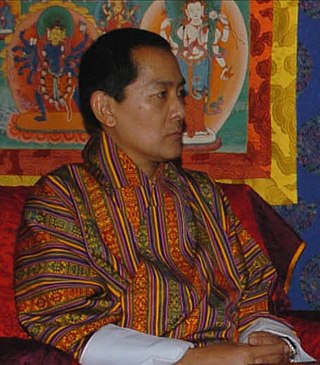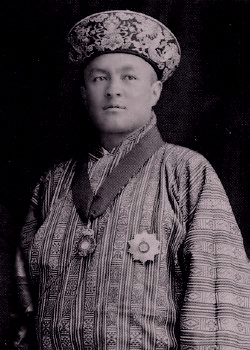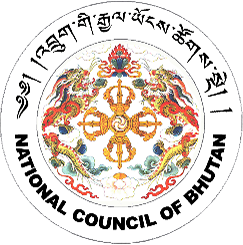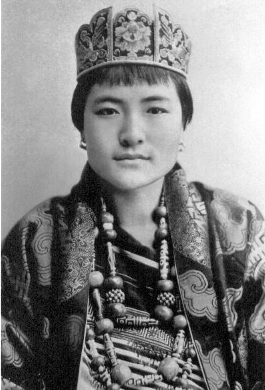
The Government of Bhutan has been a constitutional monarchy since 18 July 2008. The King of Bhutan is the head of state. The executive power is exercised by the Lhengye Zhungtshog, or council of ministers, headed by the Prime Minister. Legislative power is vested in the bicameral Parliament, both the upper house, National Council, and the lower house, National Assembly. A royal edict issued on April 22, 2007 lifted the previous ban on political parties in anticipation of the National Assembly elections in the following year. In 2008, Bhutan adopted its first modern Constitution, codifying the institutions of government and the legal framework for a democratic multi-party system.

Jigme Singye Wangchuck is a member of the House of Wangchuck who was the king of Bhutan from 1972 until his abdication in favor of his eldest son, Jigme Khesar Namgyel Wangchuck, in 2006.

The national flag of Bhutan is one of the national symbols of Bhutan. The flag features a Chinese dragon from Bhutanese mythology. This alludes to the Dzongkha name of Bhutan – Druk Yul – as well as the Drukpa Lineage of Tibetan Buddhism, which is the dominant religion of Bhutan.

Jigme Wangchuck was the 2nd Druk Gyalpo or king of Bhutan from 26 August 1926, until his death. He pursued legal and infrastructural reform during his reign. Bhutan continued to maintain almost complete isolation from the outside world during this period; its only foreign relations were with the British Raj in India. He was succeeded by his son, Jigme Dorji Wangchuck.

Jigme Dorji Wangchuck was the 3rd Druk Gyalpo of Bhutan.

The line of succession to the throne of Bhutan is based on the constitution of Bhutan. Currently the line of succession is according to male-preference cognatic primogeniture with males preceding females who are in the same degree of kinship. If the heir apparent has reached the age of majority of 21, the monarch would step down at age 65. If the heir apparent and the nearest people in the line of succession are deemed unsuitable, it is up to the monarch to decide who will be the next heir. If the monarch violates the constitution, they must abdicate.

The Royal Monetary Authority of Bhutan is the central bank of Bhutan and is a member of the Asian Clearing Union. It is also the minting authority for the Bhutanese Ngultrum. The Royal Monetary Authority of Bhutan was established under the Royal Monetary Authority of Bhutan Act of 1982. Subsequently, the Act of 1982 was amended by the Financial Institutions Act of 1992 and replaced in its entirety by the Royal Monetary Authority Act of 2010.

The National Council is the upper house of Bhutan's bicameral Parliament, which also comprises the Druk Gyalpo and the National Assembly.

The judicial system of Bhutan is the purview of the Royal Court of Justice, the judicial branch of the government of Bhutan under the Constitution of 2008. The judicial system comprises the Judicial Commission, the courts, the police, the penal code, and regulations on jabmi (attorneys).

The Druk Gyalpo is the head of state of the Kingdom of Bhutan. In the Dzongkha language, Bhutan is known as Drukyul which translates as "The Land of the Thunder Dragon". Thus, while kings of Bhutan are known as Druk Gyalpo, the Bhutanese people call themselves the Drukpa, meaning "people of Druk (Bhutan)".

The Dungkhag Court is the court of first instance of the Royal Court of Justice in 6 of the 20 Dzongkhags of Bhutan which have Dungkhag administrative divisions; in the remaining 14 Dzongkhags, the Dzongkhag Court is the court of first instance. There are a total of 13 Dungkhags (sub-districts) in the 6 Dzongkhags (districts) that contain them. Like the members of the Dzongkhag Court, the judges of the Dungkhag Court are not appointed by the Druk Gyalpo under the 2008 Constitution.

The Dzongkhag Court exists in each of Bhutan's 20 Dzongkhags, and is the court of first instance of the Royal Court of Justice in 14 of the 20 Dzongkhags of Bhutan. In the remaining 6 Dzongkhags there exists a further subdivision, Dungkhag, which is the basic level of judicial administration in those jurisdictions. The Chief Justice and Drangpons of the Dzongkhag Courts. Unlike the judges of the Supreme Court and High Court, they are not appointed by the Druk Gyalpo under the 2008 Constitution.

The Supreme Court of Bhutan is the Kingdom of Bhutan's highest court of review and interpreter of the Constitution.
The national symbols of Bhutan include the national flag, national emblem, national anthem, and the mythical druk thunder featured in all three. Other distinctive symbols of Bhutan and its dominant Ngalop culture include Dzongkha, the national language; the Bhutanese monarchy; and the driglam namzha, a seventeenth-century code on dress, etiquette, and dzong architecture. Natural symbols of Bhutan are its national flower, the Himalayan blue poppy; its national tree, the Himalayan cypress; its national bird, the raven; and its national animal, the takin.
Public holidays in Bhutan consist of both national holidays and local festivals or tshechus. While national holidays are observed throughout Bhutan, tsechus are only observed in their areas. Bhutan uses its own calendar, a variant of the lunisolar Tibetan calendar. Because it is a lunisolar calendar, dates of some national holidays and most tshechus change from year to year. For example, the new year, Losar, generally falls between February and March.

Ashi Phuntsho Choden (1911–2003) was the Queen consort of Bhutan.

LyonpoSonam Tobgye is an eminent jurist from Bhutan. He served as Chief Justice of the High Court of Bhutan from 1991 through 2009 and as Chief Justice of the newly created Supreme Court of Bhutan from 2010 through 2014. He also served as president of SAARCLAW, the South Asian Association for Regional Co-operation in Law, from 2011 through 2014. His public service spanned 43 years, beginning as master of household to King Jigme Dorji Wangchuck and ending in constitutionally-mandated retirement at the age of 65.

Ashi Pema Dechen (1918–1991) was the Queen consort of Bhutan.
DashoKeiji Nishioka was a Japanese botanist. He was dispatched to the Kingdom of Bhutan by the Japanese Government to help modernise the Bhutanese agricultural sector. Nishioka worked in Bhutan as an agriculture expert for 28 years, from 1964 till his death in 1992. Nishioka's work helped improve the cultivation of rice and vegetables in Bhutan's Paro and Zhemgang dzongkhags (districts). He also participated in civic infrastructure development efforts in Zhemgang.
Shingkhar Lam Kunzang Wangchuk was a Bhutanese politician, who served as a speaker of the Gyelyong Tshogdu. After his uncle went missing, he served two Druk Gyalpos (kings) of Bhutan. He created the insignia for the Royal Bhutan Army and rewrote the Druk Tsendhen.











